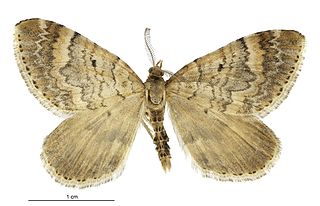
Pasiphila plinthina is a moth in the family Geometridae. It is endemic to New Zealand and is found in both the North, South and Stewart Islands. It is on the wing mainly from June until September with occasional observations up to December, and is attracted to light. This species is similar in appearance to P. sandycias but can be distinguished from it as P. plinthina has palpi that are longer and has more blurred forewing markings.

Asaphodes albalineata is a species of moth in the family Geometridae. It is endemic to New Zealand and has been observed on Stewart Island / Rakiura. This species is similar in appearance to Asaphodes oraria but can be distinguished as it has an unusual pattern on the underside of its hindwings. It inhabits open hill tops and adults are on the wing in December.

Asaphodes chlorocapna is a species of moth in the family Geometridae. This species is endemic to New Zealand and can only be found in the Chatham Islands. The larvae of this species consume the leaves of Muehlenbeckia plants. Adults are on the wing in January. This species is classified as "At Risk, Relict'" by the Department of Conservation.

Xanthorhoe lophogramma is a species of moth in the family Geometridae. It is endemic to New Zealand. It is classified as "At Risk, Nationally Uncommon" by the Department of Conservation.

Notoreas atmogramma is a species of moth in the family Geometridae. This species is endemic to New Zealand. It is a day flying moth that frequents alpine habitat.

Asaphodes dionysias is a species of moth in the family Geometridae. This species is endemic to New Zealand and is only known from mountainous areas in Central Otago. It lives in open grassy mountainous habitat at altitudes up to 1750 m. It is also known to live in wetland habitat. The larvae of this species feed on native herbs. The adults of this species are on the wing in January and February. The adult female of the species has reduced wing size in comparison to the male.

Asaphodes limonodes is a species of moth in the family Geometridae. It is endemic to New Zealand and is found in both the North and South Islands. This species inhabits damp native forest. Adults are on the wing from November until March.

Notoreas arcuata is a species of geometer moth endemic to New Zealand.

Notoreas hexaleuca is a species of moth in the family Geometridae. This species is endemic to New Zealand.

Notoreas ischnocyma is a species of moth in the family Geometridae. This species is endemic to New Zealand. This species is found in Canterbury and Otago.

Notoreas isoleuca is a species of moth in the family Geometridae. It is endemic to New Zealand.

Notoreas mechanitis is a species of moth in the family Geometridae. It is endemic to New Zealand.

Notoreas niphocrena is a species of moth in the family Geometridae. It is endemic to New Zealand.

Notoreas ortholeuca is a species of moth in the family Geometridae. It is endemic to New Zealand.

Notoreas paradelpha is a species of moth in the family Geometridae. It is endemic to New Zealand.

Notoreas perornata is a species of moth in the family Geometridae. It is endemic to New Zealand.

Notoreas simplex is a species of moth in the family Geometridae. It is endemic to New Zealand.

Paranotoreas brephosata is a species of moth in the family Geometridae. This species is endemic to New Zealand.

Asaphodes omichlias is a moth in the family Geometridae. It is endemic to New Zealand and has been observed in both the North and South Islands. This species inhabits rocky, open country in high mountains. Adults are on the wing in January and February. The appearance of the adult of this species is variable with some specimens having a paler and more grey appearance than the more usual brown appearance.

Asaphodes sericodes is a moth in the family Geometridae. It is endemic to New Zealand and has been observed in the southern parts of the South Island. This species inhabits open tussock grasslands in subalpine scrub or wetlands. The female of the species is likely semi-apterous and is flightless. The adult males are on the wing in January.























